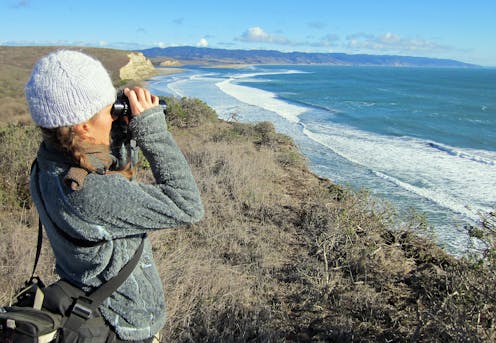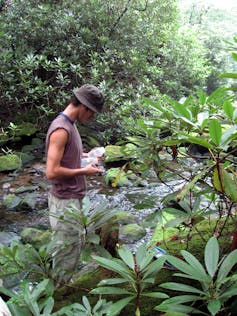Citizen scientists are filling research gaps created by the pandemic
COVID-19 kept many scientists from doing field research in 2020, which means that important records will have data gaps. But volunteers are helping to plug some of those holes.

The rapid spread of COVID-19 in 2020 disrupted field research and environmental monitoring efforts worldwide. Travel restrictions and social distancing forced scientists to cancel studies or pause their work for months. These limits measurably reduced the accuracy of weather forecasts and created data gaps on issues ranging from bird migration to civil rights in U.S. public schools.
Our work relies on this kind of information to track seasonal events in nature and understand how climate change is affecting them. We also recruit and train citizens for community science – projects that involve amateur or volunteer scientists in scientific research, also known as citizen science. This often involves collecting observations of phenomena such as plants and animals, daily rainfall totals, water quality or asteroids.
Participation in many community science programs has skyrocketed during COVID-19 lockdowns, with some programs reporting record numbers of contributors. We believe these efforts can help to offset data losses from the shutdown of formal monitoring activities.
Why is uninterrupted monitoring important?
Regular, long-term tracking of phenomena such as plant and animal abundance, composition and activity is critical for understanding change. It enables researchers to see the impacts of natural disturbance events, such as wildfires, and human activities, such as construction and development. Long-term studies offer insights into patterns and processes that can’t be derived from shorter studies, and help experts make better predictions about the future.
Interruptions in monitoring make it harder to accurately assess changes. If those disruptions coincide with extreme events, such as a major hurricane, experts miss opportunities to understand the full impacts of those events.

The U.S. has several long-term ecological monitoring programs, including the National Ecological Observatory Network (NEON), the Long Term Ecological Research Network and federal inventory and monitoring programs. Many state and local government agencies carry out similar activities. The pandemic has significantly disrupted all of these programs.
Reasons to engage the public in science
Community science is a strong complement to formal research. By engaging willing volunteers, community programs yield much more data and cover larger areas than professional scientists can achieve on their own.
We help manage two popular biodiversity-themed community science programs in the U.S.: eButterfly, a program for tracking butterfly sightings, and Nature’s Notebook, a program for tracking seasonal activity in plants and animals. Scientists have used data contributed by participants in these programs to verify information collected by satellites, determine the conditions associated with flowering in different species of plants, and predict how climate change will shift plant species’ ranges in the future.
Observations contributed to other community science programs have helped to document new insect species, discover exoplanets and even find cures for rare diseases. Globally, millions of people participate in thousands of projects, resulting in data valued at more than US$1 billion annually.
Community science programs also benefit participants. Joining a community science program can make people more science-literate and help pull back the curtain on how scientific work is done. It also deepens their sense of place and increases their understanding and appreciation for the plants and animals they monitor. We have frequently heard from our participants that making observations has enabled them to see and experience much more in places they know well, and to enjoy those places all the more.
Community science to the rescue
As offices and schools closed in the spring of 2020, many Americans turned to community science programs in search of stimulating and meaningful activities for children and adults alike. And despite COVID-19 restrictions, volunteer data collectors have persisted through the pandemic.
In a recent analysis of activity in biodiversity-themed community science programs during COVID-19 lockdowns, we found that participation generally held steady or increased in the spring of 2020. Two popular programs, iNaturalist and eBird, both grew. Participation in Nature’s Notebook and eButterfly declined slightly, though volunteers still logged many critical observations. What’s more, community science volunteers in these programs and others have kept at it even as lockdowns have relaxed.
How good is community data?
One common question about community science projects is whether data collected by volunteers is reliable. This is a valid concern, since many program participants are not formally trained as scientists.
Organizations that run community science programs typically go to great lengths to ensure data quality. To avoid recording erroneous observations, project leaders provide extensive training and support materials. They also construct data entry apps so that volunteers can’t mistakenly input dates in the future, and flag inconsistent reports for review. Several biodiversity-themed programs, including iNaturalist, eBird and eButterfly, engage expert reviewers to evaluate and verify reports.
According to a 2018 review by the National Academies of Science, Engineering and Medicine, on average, volunteer contributors yield reliable data points about 75% of the time. For some programs, such as Nature’s Notebook and eBird, accuracy is over 90%.
How to get involved
Your observations can help fill critical gaps that COVID-19 closures have created. Contributions to iNaturalist, eBird, eButterfly or Nature’s Notebook are welcome any time of the year, but spring is an ideal time to contribute observations to biodiversity-themed programs to help document plant and animal response to changing seasonal conditions. For example, participants in Nature’s Notebook will help document whether springtime plant and animal activity is early amid the ongoing effects of climate change.
The 2021 City Nature Challenge, an effort using iNaturalist to document urban biodiversity in brief, focused events, will run in late April and early May in cities worldwide. Another event, Global Big Day – a single day focused on celebrating and recording birds worldwide – is scheduled for May 8. Even if you’ve never thought of yourself as a scientist, you can help scientists collect data that expand our understanding of the Earth and how it works.
[Deep knowledge, daily. Sign up for The Conversation’s newsletter.]
The University of Arizona receives funding from the U.S. Geological Survey, the U.S. Fish & Wildlife Service, the National Science Foundation, and the National Aeronautics and Space Administration to fund the USA National Phenology Network.
Kathleen Prudic does not work for, consult, own shares in or receive funding from any company or organization that would benefit from this article, and has disclosed no relevant affiliations beyond their academic appointment.
Read These Next
The ‘one chatbot per child’ model for AI in classrooms conflicts with what research shows: Learning
AI tutors are often held up as an ideal, but prioritizing individualized teaching can detract from the…
How the NIH became the backbone of American medical research and a major driver of innovation and ec
The agency’s budget has grown steadily since the 1960s, fueling an industry that creates lifesaving…
Best way for employers to support employees with chronic mental illness is by offering flexibility
Employers that don’t support employees with mental illness risk missing out on the talents and skills…





